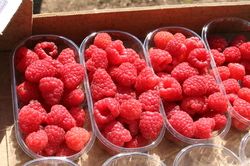 In the stationary market, the sales figures for the most important soft fruit variety, raspberries, are largely supply-driven: ultimately, what is sold is what buyers purchase and then what is offered at the points of sale. With the online range of our sister company Lubera.com, the situation is largely reversed: we sell what is in demand.
In the stationary market, the sales figures for the most important soft fruit variety, raspberries, are largely supply-driven: ultimately, what is sold is what buyers purchase and then what is offered at the points of sale. With the online range of our sister company Lubera.com, the situation is largely reversed: we sell what is in demand.
From mid-February until Christmas, a wide range of 36 raspberry varieties is continuously available. According to the sales figures at Lubera.com, we can therefore deduce reasonably objectively what the natural demand for raspberry plants is with a wide range of raspberry plants.
Bestselling raspberry varieties
As mentioned, Lubera.com offers 36 raspberry plants in its assortment, in around 50 different products (as some varieties are offered in different sizes). The absolute bestseller is Primeberry® Autumn First® with 16.5% of all plants sold.
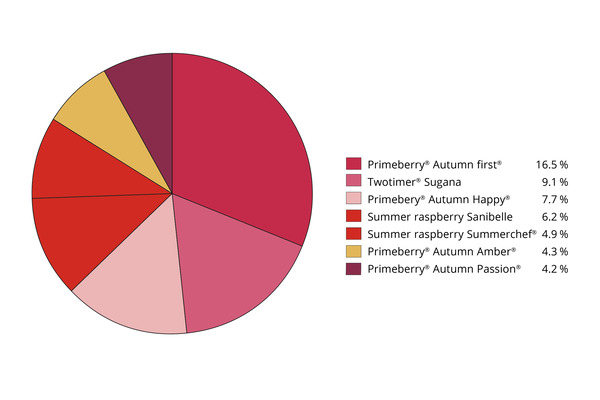
Figure: The seven best-selling raspberry varieties at Lubera in 2023
The seven best-selling varieties account for more than 50% of the total sales; nevertheless, the long tail is considerable, with the remaining 30 or so varieties also accounting for almost 50%. This can be taken as an indication that it is worth offering speciality varieties of raspberries, the most important berry fruit, if you want to exploit the full market potential. Nevertheless, it is also obvious to conclude that Lubera.com's range of varieties is probably too wide for this. But our colleagues at our sister company are allowed to make mistakes – and above all, they have to provide us with broad experience and figures...
The good position of the two summer raspberries Sanibelle® and Summer Chef® is striking. Although we also offer well-known old varieties such as Willamette, Meeker and Tulameen, sales are concentrated on the newer and supposedly less well-known Lubera varieties (even though they are more expensive). The scepticism towards new protected varieties (too expensive, too unknown!) should therefore also be viewed with scepticism...
Although the 'yellow raspberry' and 'black raspberry' niches are relatively limited, two varieties (Autumn Passion® and Autumn Amber®) can be found here in the bestseller list. It is therefore quite possible to cover these 'smaller' market segments well with the right varieties (and also with a few varieties) and then achieve significant sales with them.
Raspberry types
As you would expect, classic autumn raspberries account for almost exactly 50% of the demand. If we were to add the compact autumn raspberries and the Twotimer® raspberries (all of which are also autumn raspberries), we would be at 70%.
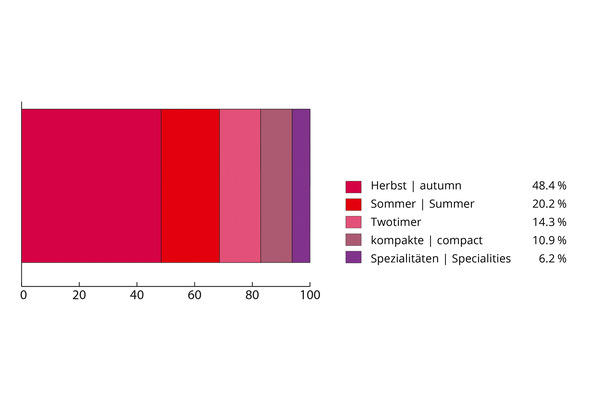
Figure: Percentage distribution of raspberry plants sold - broken down by the different types of fruit
The only 10% for compact raspberries (Lowberries® and Schlaraffia®) is somewhat striking, as these sales have also fallen relative to the last analysis (they have risen slightly in absolute terms). Apparently, it is easier to sell 'classic' autumn raspberries and summer raspberries and increase sales (+20% compared to 2022) than to try to do the same with speciality raspberries. Conversely, there is also the task (at least for Lubera.com) of raising awareness of compact raspberries and their advantages (ideal for pots, on balconies and terraces, plant and harvest), especially among younger gardening beginners.
The specialities include Japanese wineberries, Arctic raspberries and salmonberries. They have a place when the wide use of raspberries as solitary shrubs (salmonberries) and as ground cover (Arctic raspberries) is to be promoted.
The colour of a raspberry is...red
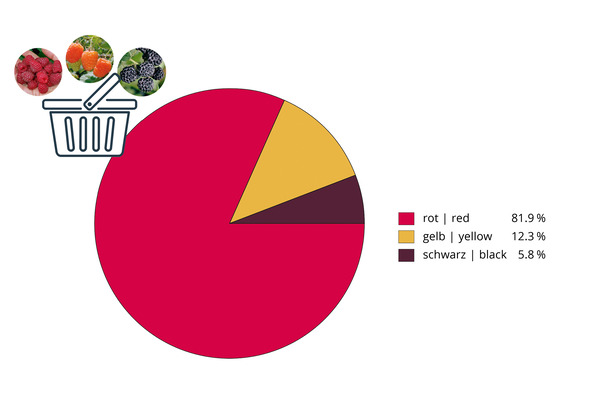
Figure: Percentage distribution of raspberry plants sold - broken down by fruit colour
The raspberry colour is and remains red; yellow raspberries sell at a good 12%, black and purple raspberries at just under 6%. As already mentioned above, these colours can be covered well with a few varieties (a yellow autumn raspberry, a purple autumn raspberry and possibly an additional black summer raspberry).
The ideal plant size for raspberries is...small
We also offer large plants of the most important varieties in 5-litre pots at Lubera.com – but these only reach about 5% of the sales.
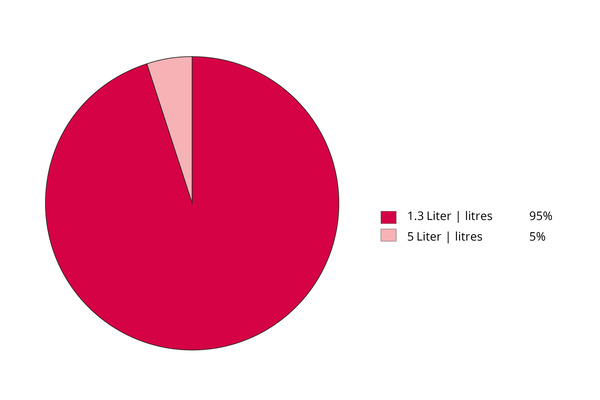
Figure: Percentage distribution of raspberry plants sold - broken down by pot size
The standard size at Lubera.com is a 1.3-litre pot – which also fits well with the intended use of raspberries: they are simply not planted individually in many cases, but as groups or in rows – and it is much easier to pack in half a dozen smaller plants than a whole car boot full of 5 L plants. The logic of the 2 L and 3 L raspberry plants offered on the market is understandable; they are ultimately intended to provide a uniform supply for all soft fruit. However, the question remains as to whether smaller plants that are better suited to use in the garden could also make sense here...
